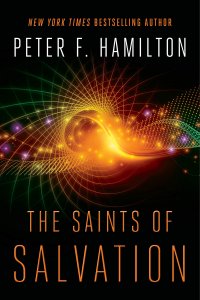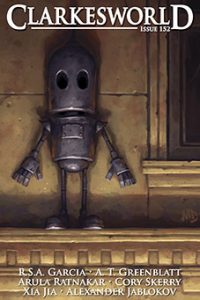Paul Di Filippo Reviews The Saints of Salvation by Peter F. Hamilton
 The Saints of Salvation, Peter F. Hamilton (Del Rey 978-0-399-17888-7, $32, 528pp, hardcover) November 2020.
The Saints of Salvation, Peter F. Hamilton (Del Rey 978-0-399-17888-7, $32, 528pp, hardcover) November 2020.
One shameful sensation experienced by the over-burdened reviewer—or by any reader, I suppose, with more books than time—is how many series of novels one begins but then abandons, due solely to time constraints. For instance, after complete enjoyment of their predecessors, I have been unable to make time to read the fourth book in Paul Park’s A Princess of Roumania cycle, nor the third book in Gene Wolfe’s The Book of the Short Sun series. Too many newer books pile up in their wake, demanding professional attention. And the hours devoted to research reading and purely recreational reading are too few to stretch.
So it is with a sigh of relief and a gust of satisfaction that I take up the concluding volume of Peter Hamilton’s newest trilogy, avoiding another defeat, and find myself amply rewarded. This is a massive, knock-your-socks-off, bravura finish, rich with enough material for a mini-trilogy of its own. Hamilton plainly expresses zest and pleasure at his visionary composition on every page; his conceptualizations are unrelenting; and his prose is microgrooved, every part spinning frictionlessly to contribute to the movement of the whole engine. I’m so glad I did not miss this!
If you need to get up to speed with the first two books, you can check out my Locus Online reviews at this link for the first, and this link for the second.
The narrative template of disjunct spacetime venues that Hamilton employed in the first two volumes continues here, but with modifications.
First, “realtime” focus on the events closest to our era, set in the 2200s, comes to an end about a fifth of the way through this book, giving that prominent character Ollie whom I cited in my review of Salvation Lost a heroic ending. Second, the separate casts of space travelers—the crew of the Avenging Heretic, launched in the 2200s, and humanity’s far-distant heirs, typified by the lovers Dellian and Yirella—eventually meet and fuse. But there’s a lot of action before that happens. Also, in the post-climactic sections, we actually do get threads from the 2200s tied up—twenty thousand years later!
Just to recap briefly. Humanity has been subverted by ostensibly friendly aliens named the Olyix. They are running a secret jihad which sees them harvesting any sentients they encounter for eventual tribute to some Omega Point God who, they claim, has directed them from the end of the universe to do so. When the motives of the Olyix become evident, they destroy Earth. A portion of humanity flees in a ragtag fleet and via stargates across the galaxy. But five humans aboard the Avenging Heretic have stowed away inside a gigantic Olyix ship and are riding it back to the main base of the aliens, intending to wreak what havoc they can, and send out a message to our species.
Meanwhile Yirella and company, ten thousand years after Earth’s destruction, have become advanced enough in their tech to try finally to wipe out the Olyix. This possibility has arisen mainly because Yirella, in a rogue move, seeded a brand new kind of human colony around a neutron star and let it grow unconstrained by old precepts and limits. This results in a tribe of “corpus humans,” whose spokesperson is one Immanuel. When Yirella and the corpus humans meet up, she is revered as their founder—the “genesis human”—and all the forces unite to take the battle home to the Orylix and rescue the “cocooned” humans harvested from Earth.
What these posthumans don’t realize at first is that the five saboteurs aboard the Avenging Heretic—folk heroes deemed “Saints” for centuries—are still alive, thanks to the timeflow manipulations inside the Orylix enclave. When past reunites with present, the Orylix are doomed. But not without immense challenges, reversals, cliffhangers, unpredictable fatalities, and enough super-science space fighting to render Edmond “World Wrecker” Hamilton dizzy.
As I mentioned above, our modern Hamilton allows a generous fifty pages or so for the post-war tidying up, a series of quiet events which trigger in well-earned resonant fashion a burst of emotional fireworks. And oh yes, he seems to promise further adventures in this universe!
I fear I must repeat myself somewhat, in line with my previous assessments. Hamilton does a bang-up job with character building, he juggles the incidents of his plot with flair and panache, and he excels at making his speculative technology at once exotic and crystalline.
The Signal transmitter vehicles were the best stealth technology Kruse Station could devise, combining human and Neána technology. The development team had utilized the concept employed by the Neána insertion ship to produce spheres four meters in diameter with a matte black body that was totally light absorbent. Internal heat sinks meant they maintained an ambient thermal profile, and their systems were shielded to prevent any electromagnetic emission. Instead of a gravitonic drive, they had an external layer of active molecular blocks, which meant the entire fuselage was a rocket motor with an exhaust of cold neutral atoms, which left only the faintest of traces. In theory, it should be no different from a gust of solar wind particles.
That’s just a quasi-random sample. I could extract brilliant stuff like that from practically every page.
In short, Hamilton continues to produce the Platonic model of twenty-first-century space opera, in line with such folks as Neal Asher and Adrian Tchaikovsky.
To make up for recycling my earlier assessments, I will now conclude with a new observation, regarding the topicality of this book, whose themes at first seem as distant as possible from current events of 2020. But always remember John Clute’s notion of “the Real Year” of any SF text.
The first hook to the present is that Hamilton’s Earth is experiencing a biological plague. The “K-cell” cocooning of humanity is pure body horror, and speaks to our Covid plight.
But more importantly, as a theme, is the nature of the Olyix.
They actually embody the worst aspects of our own extremist conservative and progressive factions.
Like many of our worst conservatives, they are motivated by a blind religious dictate that brooks no denial.
Like many of our worst progressives, they maintain that they alone know the “arc of history” and are just forcing everyone else to bend to it for our own good.
Both positions reek of a sanctimonious hypocrisy allied with brutality and disregard for individual rights.
And how are these hybrid extremists defeated? By a literal incursion from the past—the living Saints—uniting with a branch of humanity—the corpus humans—who have been freed from ideological blinders.
“He gave them no advice,” [Yirella] said, then paused to smile shrewdly. “At least, that’s what he told me he was going to do. We planned to give them the facts—all the knowledge humans have amassed; dispassionate accounts of our history and the societies we’ve evolved for ourselves; everything we know about the Olyix. That way, they can choose for themselves how they will live. For that is what real freedom is.”
Could there be a more relevant message for our period in time, concealed inside this highly entertaining SF vessel? Keep the foundational accomplishments of our ancestors close to our hearts, and proceed with eyes unclouded by dogma. That’s the way you defeat any extremists, whether they hail from your own backyard, or from the farside of the galaxy.
 While you are here, please take a moment to support Locus with a one-time or recurring donation. We rely on reader donations to keep the magazine and site going, and would like to keep the site paywall free, but WE NEED YOUR FINANCIAL SUPPORT to continue quality coverage of the science fiction and fantasy field.
While you are here, please take a moment to support Locus with a one-time or recurring donation. We rely on reader donations to keep the magazine and site going, and would like to keep the site paywall free, but WE NEED YOUR FINANCIAL SUPPORT to continue quality coverage of the science fiction and fantasy field.
©Locus Magazine. Copyrighted material may not be republished without permission of LSFF.








This trilogy has been the worst Hamilton experience I had.
I never got stuck more in all the fluff and obsolete technical info and storylines, genders and characters in different timeframes and forms and flashbacks as flashforwards.
The lengthy explanation about portals, wormholes, time shifting etc etc feel like I am reading the yellow pages instead of a good science fiction novel!
DO NOT READ! Read ANY other book by Hamilton…even Misspent Youth is 1000X better than this fluff!
I totally disagree with Karel. The Salvation trilogy is the absolute masterpiece with strong emotional content across all books. While reading it, I really felt like actually living it. I also read almost all Peter’s books, except maybe couple of early novels and I fell in love with all his different Universes. He managed to create real transdimensional portals between the pages of his books and transport readers right there where they can personally feel such an exciting future possibilities.
It’s not Hamiltons best. Slack editing, all too common with popular authors (“more is more”). Also, some parts are far too close to an alien version of 50 Shades.
Lose some mid- life libido and cut to two books!